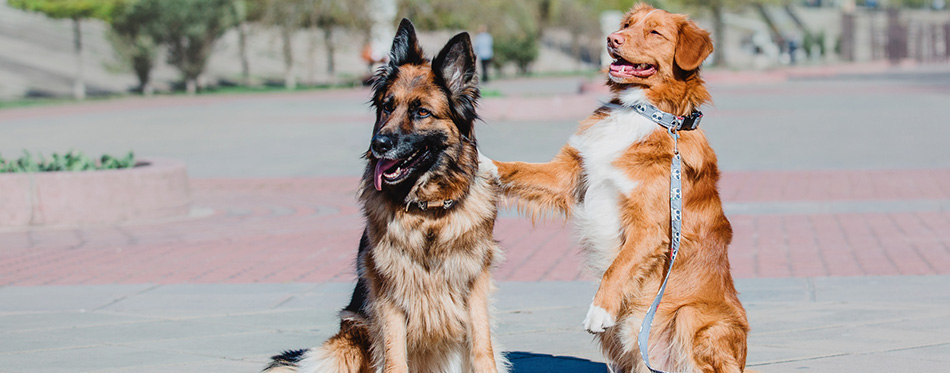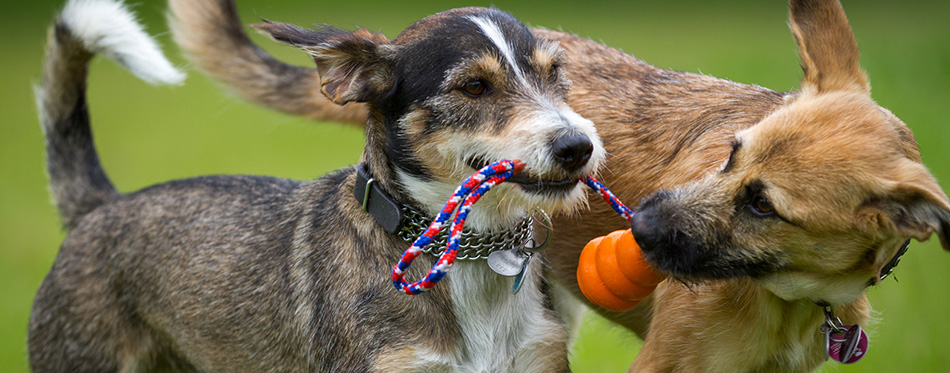One dog just isn’t enough for most pet owners. It’s because of this that families get second, third, and eventually even more dogs that help bring them joy. It’s easy to get a dog from pet shops or from adoption centers. However, introducing the new pooch to the old-timers could prove to be quite challenging. To make it a bit easier on the new pet owners out there, here are a few tips on how to introduce a new dog to the older ones. Follow these and your dogs will be the best of friends in no time.

Slow and Steady
The first, and probably the most important, piece of advice to follow when introducing a new dog is to do it as slowly and carefully as possible. Why, you may ask? Well, if it turns out that the dogs don’t like each other as much as we’d hoped for, then one of them might end up getting hurt. You might also want to keep the dogs on their leashes during the first few meetings. This is to let them get used to each other’s presence first. However, you should ease up on the tension to allow the dogs to move around.
A good example of this is when you go to pick up your new dog. It would be for the best if the older dogs were left at home while you make your way to the pet store or to the shelter. You may have a difficult time managing the interactions between old and new dogs while driving home. The confined space won’t make them feel any better towards one another as well. It may not end well if you choose to make your dogs meet this way.
As much as possible, try to keep your new dog and your old dog visually separate from one another. Not only are you trying to minimize their physical contact with one another, but you are also trying to reduce the amount of time that they get to see each other. You can accomplish this by keeping them in separate rooms of the house. You could also make your older pet an outdoor dog for the time being, while the younger one gets to know its new environment. If you lack the space, you could simply face their carriers away from each other.
Neutral Grounds
It would also be advisable to have the pooches meet on “neutral” territory. This could be a neighbor’s yard, a dog park, or even a tennis court. It doesn’t matter where you’ll have your dogs meet, just as long as it’s not a place where one of them has grown accustomed to. Make sure they also have enough room to move around where they meet. A closed and confined space could mean trouble if the dogs don’t end up warming up to each other during the beginning stages of getting to know each other.
Try to keep the first few meetings short. For example, during the first meeting just let them sniff each other for a couple of minutes. After that, end the meeting. In the next few sessions, if all goes well, give them a couple minutes to play with one another. Just make sure that each meet-up between the two ends on a high note. During breaks, it would also be wise to give the dogs treats to show them that interacting with one another is an expected behavior. This conditions them to behave when they are with one another. They may even look forward to it.
Related Posts: Vegan Dog Treats and Dog Treats
One at a Time
If more than one of your resident dogs shows resistance to the latest member of the family, then try to introduce your new furry friend to the senior dogs one by one. This would greatly reduce the tension in this situation and allows for easier and faster adjustment. Observe the body language of the dogs during these first few meetings. If they appear guarded or defensive, then now may not be the right time to introduce them to one another. Distract them with other activities first and then try to get back to it a little later on in the day.
You should think about whether the dogs you are introducing to one another are social. Some dogs find getting along with others quite easy. However, there are some dogs that have difficulty interacting and have only had a couple of friends in their life. If this is the case, then a bit more effort is needed to get a successful result. Dogs being spayed or neutered can also factor into how they interact with others. If they are not neutered, you may have a harder time handling them when they are meeting with someone for the first couple of times.
If possible, get someone else to help you out, too. It would be easier to let two or more dogs get to know each other if each of the dogs has a “handler.” Just be sure that these handlers, as well as yourself, have a positive attitude towards the meeting. This will help keep the scenario calm and positive for both the humans as well as the animals. Also, having other people on hand to help you control your pets will be extremely helpful if the situation ever goes sour. We sure hope that it doesn’t, though.

Show the Older Dogs Some Love
After the initial interaction, you may want to take some time to comfort your old dog. He or she might be sad, or maybe even jealous, that you have allowed a new pet into what they consider as their home as well. Comforting older dogs makes them feel that they are wanted and that they are still important. You have to make sure that you remain patient with them. Also, try to find time to do their favorite activities. Don’t be too preoccupied with your new pet.
If your resident dog is older, you should also look out for signs of fatigue. If your old dog starts to look sluggish then it may be for the best interests of everyone involved to give them some “quiet” or “alone” time. Resident dogs may get tired out by their interactions with the newer dogs. If this is the case, separate them for a little bit with some of their favorite objects. In some cases, you may also want to consult with a veterinarian. As mentioned, spending some quality time with just your older dogs is another great pick-me-up for them.
Physical Contact May Not Be Enough
Aside from sight and physical contact, there are other ways that dogs get to know one another. One of the more potent ones is through smell. The way to do this is by placing something of the newer dog’s in the older one’s cage and vice versa. For example, you can let the newer dog borrow one of the older dog’s blankets, while the resident dog can play with one of the newer pup’s toys. This will allow them to get used to each other’s scent and not be so aggressive when they eventually come into contact.
You can have your dogs meet at home if you feel that they have already grown more comfortable in each other’s company. However, there are still some precautions to take. Take the resident dog to the yard first before bringing the new dog inside the house. You can then have them meet afterwards. Just remember to keep the first couple of meetings short and to end it immediately if tensions begin to flare up between the dogs. Having your pets meet at home is also beneficial to the newer dog, as it allows him or her to become familiarized with the house’s layout.
After giving the newer dog a chance to roam around the house, allow your pets to switch roles. When it is the older dog’s turn to have a stroll around the house, he will get a chance to get used to the smell of his new brother or sister. When you are not at home; however, always make sure that both of your dogs are kept in separate places if they are not yet used to being with one another. They could be in different rooms or in the same room, but in different crates. The important thing is that their first interactions in the house are regulated.

In Summary…
So if you’re looking to add a new dog, but are unsure of how your older pets may feel, then following these few simple steps will make the entire process that much easier. Always remember to keep their initial interactions at a minimum and to end them on a high note, as this helps avoid tension between old and new pets. Having them meet in open spaces with a couple of people tagging along will also be helpful. This also allows dogs to have an escape route if things go south during the meeting. You should also expose them to each other through sight, smell, or physical contact. But most importantly, treat all of your furry friends with lots of love.
Sources:
- How to Introduce Your Dog to a New Dog – AKC
- Introducing a New Dog to Your Current Dog – The Ohio State University – College of Veterinary Medicine

